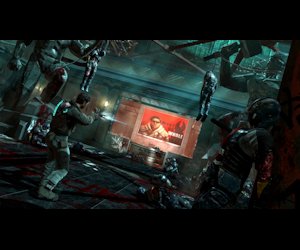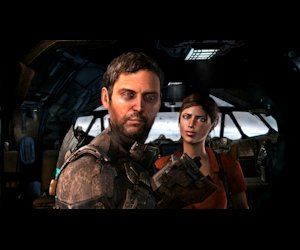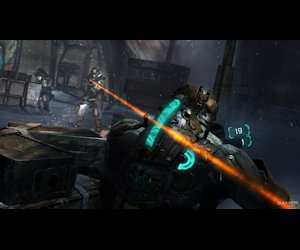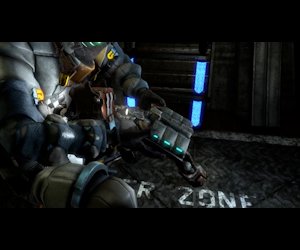Solo Gamer Review: Dead Space 3
Survival horror is a difficult thing to get right. It's the only video game genre that deliberately shackles the player with things like extremely limited ammunition, restrictive camera angles, and slow movement, and when it's done right, the effect can be both nerve-racking and wonderfully terrifying. Much like horror movies that stack the deck with claustrophobic settings and characters that leap across the line between brave and stupid, these conventions are tried and true ways of instilling fear in a willing audience. Though they can easily be overused--resulting in schlocky films and aggravatingly cheap games--producers working in the genre need to respect them for what they are.
The original Dead Space does it almost perfectly. The setting is dark enough to be scary without being so shadowy that you can't see anything; weapons are repurposed engineering tools instead of super-powered assault rifles; ammo is just scarce enough to keep you on your toes without constantly keeping you defenseless; the enemies are hard enough to be dreaded without being controller-slingingly impossible; the story is just twisted enough to be disturbing without being hokey; and the innovation of a HUD-less health bar and an inventory system that doesn't let you pause are brilliant ways to move the genre forward. Its sequel, Dead Space 2, with its heavier focus on action, isn't quite as successful, though it is by no means a failure as a survival horror experience. Now, though, with Dead Space 3, the developers have chosen to push the action even further with a more extensive weapons system, an emphasis on co-op play, an expansive new setting, and more. The question, then, is whether this third entry still holds true to its survival horror roots, or has the franchise devolved into a generic third-person shooter?
STORY
 | | Those Unitologists be crazy! |
Three years after the Titan Station Incident of Dead Space 2, we find Isaac Clarke hiding in relative seclusion on a lunar colony. A pair of EarthGov soldiers who claim to be working with Ellie Langford track him down and inform him that she needs his help dealing with something big related to the markers. At exactly the same time, a band of Unitologist terrorists lead by a fanatic named Jacob Danik destroys a marker test facility nearby, sparking a necromorph outbreak on the Moon. Isaac is forced to trust the pair of soldiers as they help him escape, and he eventually finds himself at Tau Volantis, an icy planet that may just be the birthplace of the original marker.
Unlike Dead Space 2, this story adds to the mythology of the series, feeling in many ways like a climactic coming together of several lingering plot threads. The secrets of Tau Volantis are both fascinating and frustrating, simultaneously answering many long-standing questions (such as the meaning of "make us whole" and why there doesn't seem to be any alien life in the universe) while opening up even deeper mysteries that have no easy solutions. Without giving too much away, there is one twist that pulls the rug out from under you, revealing many of the answers to be a giant red herring. Even taking that into account, however, fans who have been drawn to the deeper Dead Space universe should be pleased with how this entry decides to move forward instead of running in place like the last entry.
Unfortunately, the same cannot be said of the characters. When we last saw Isaac Clarke, in Dead Space 2, his sanity and memory are suspect after his two run-ins with the necromorph menace. Dead Space 3 seems to ignore that part of his personality, portraying Clarke instead as a man certain of his own sanity, but exhausted by his experiences. Clarke is at times bitter, abrasive, and hard to sympathize with this time around, and his romantic attachment to Ellie completely ignores his previous relationship to the late Nicole Brennan. Nicole isn't even mentioned, replaced instead by a tiresome and annoying love triangle between Clarke, Ellie, and an over-the-top asshole named Robert Norton. The primary human villain, Jacob Danik, is also bland as can be, and the one genuinely interesting character, John Carver, is only explored in the co-op missions, leaving the solo gamer in the dark.
 | | You'll get sick of the relationship subplot several hours before it goes anywhere |
What the previous game lacks in mythology, it makes up for in memorably messed up moments like the infamous eye-poke machine. With Clarke's sanity no longer in doubt anymore--indeed, almost all of the madness-inspired motifs are notably absent from the single player campaign--Dead Space 3 just can't muster up anything even remotely like it. You are instead left with a clunky boss battle with a giant drill (no, I'm not kidding) and absolutely nothing that is psychologically unsettling. Even the creepiest thing about the original Dead Space--the drop-kicking dead baby necromorphs--is missing here, replaced instead with similar necromorphs made from dogs, in a none-too-subtle homage to John Carpenter's The Thing. It's almost like the creators of Dead Space 3 are trying to play it safe and are worried they might offend audiences.
One major complaint I have with the story--and this paragraph contains a minor spoiler--is that it fails to address Isaac and Ellie's apparent immunity to the necromorph infection. With half a dozen characters thrown into the mix this time around, I don't understand why none of them seem to go suicidally insane. (Granted, there are hints that Carver is mildly affected during co-op missions, but the solo gamer never sees this.) Also, since we're on the subject, I am again annoyed that the necromorph outbreak that begins the game happens quickly and off-screen.
In the end, even though the mythology is finally addressed in a meaningful way, the rest of the story winds up feeling generic and antiseptic. The characters and their relationships are uninspired, the inevitable deaths aren't as poignant as the story wants them to be, the horror is reduced to one jump scare after another instead of anything that might get under your skin, and the boss battles are fairly mediocre. There are some great action moments--especially the crash-landing on Tau Volantis, probably the finest moment in the entire game--but they are few and far between.
|
[Story: 6 - The Dead Space universe is fleshed out in a satisfying way, but the characters are uninteresting, Isaac Clarke is taken too far from the hero we know, and the overly convenient plot is sorely lacking in psychological horror.]
|
|
GAMEPLAY
 | | Those necromorphs are great and all, but I play Dead Space for all the shooting at soldiers with assault rifles that you can't get out of every other game on the market |
The most drastic gameplay change this time around is the weapon crafting system. As an engineer, Isaac can build his own weaponry out of spare parts and materials he finds hidden away throughout the game world. Ammunition is universal now, and you can only hold two weapons at any one time, so you no longer have to save space in your inventory for several different ammo types. Also, well-known stalwarts of the franchise like the plasma cutter, line gun, and ripper blade aren't as effective anymore as the "military engine," which is a classic machine gun type that can be modified to become a sniper rifle or shotgun. The customability is great, and the game encourages you to mix and match by allowing you to fully dismantle your weapons without losing any of their component parts. Things like acid bath ammunition and stasis bullets are incredibly useful, and the ability to assign nearly anything to your secondary weapon slot allows you to have a weapon that can be used both from a distance and in close quarters.
The dismemberment mechanic that defines the series--forcing veteran gamers to reprogram their gut instinct to always go for the headshot--is still there, but it's nowhere near as prominent as before. This isn't helped by the fact that, in several points in the game, you are tasked with mowing down living human opponents. These wildly out-of-place parts of the game feel like they belong in a clumsy third person shooter. There's even an achievement for scoring a certain number of headshots, and if that doesn't go against the very nature of the Dead Space franchise, I don't know what does.
Your suit undergoes significant changes this time around as well. From the very start, all of your inventory slots are opened up and you have an air capacity nearly double the maximum from the original Dead Space. Different suits are available from suit kiosks, but the only differences are cosmetic; every single suit has the same armor rating, movement speed, and air capacity. You can upgrade your stats using a mixture of found materials, but with your starting powers relatively high and the maxed out RIG being only slightly better, the game never forces you to make difficult upgrade choices or allows you to suit up like an overpowered tank. It almost feels like the RIG upgrades are simply there out of habit, because they aren't terribly important to the gameplay. This is perplexing given the wealth of customization available in the weaponry.
 | | Scavenger bots are a cool new addition |
While collecting health, ammo, and upgrade tools has always been part of the Dead Space formula, the drive to collect things is put on steroids this time around. In earlier games, players would have to weigh looking around for more materials that might not be there with the knowledge that difficult enemies could be lying in wait around any corner. Here, though, you always know that there are materials waiting for you and the game is very forgiving about putting anything difficult in your way. With so many customization options available to you depending on how much stuff you collect (and with generous inventory space), it becomes far too easy to obsess over looking in every nook, and the necromorphs start to become more of a nuisance than anything else. In a classic survival horror game, ammo, health, and collectables are scarce, but in Dead Space 3, they are ridiculously abundant, not to mention the fact that you can craft almost any item you need if you can't seem to find it lying about.
The game even offers you "scavenger bots" that can scour a room, collect resources, and deposit them for you at work benches (which are all linked, Resident Evil-style). I like these little guys, but it's not made entirely clear within the game how they work, and when you do finally figure out how to locate resource hotspots, it becomes another terrible distraction from the core gameplay. Again, the necromorphs become a nuisance, just getting in the way of your scanning for resources. Though having distractions like this is a good thing for many other genres, they detract from the emotional impact of a game that is trying to establish fear.
-e. magill 3/5/2013
|
|